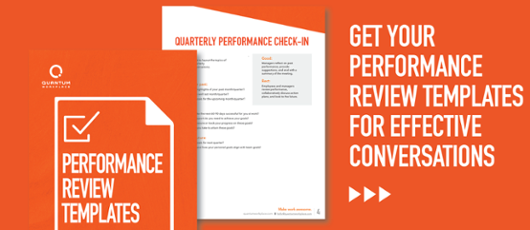5 Performance Appraisal Methods That Will Fail
 Performance management is a tricky thing to handle, and it’s incredibly easy to get it wrong.
Performance management is a tricky thing to handle, and it’s incredibly easy to get it wrong.
However, there are particular performance appraisal methods that are worse than others (read: that will never work).
Not only are these methods ineffective, but they destroy most of the benefit that could come out of an employee performance review.
Here are our five worst offenders:
1. Ratings scale.
A rating scale method uses numeric scales to measure performance items such as dependability, leadership, and timeliness. A reviewer rates each performance criterion for each employee from poor to excellent.
What’s missing: Performance over time. A rating scale can only capture information at the time the rating was given; it can’t account for employee growth. And because the information is numeric, a rater’s biases can greatly impact the review. Lastly, a rating scale destroys the ideal coaching relationship.
2. Self-evaluation.
A self-evaluation asks the employee to reflect on his or her performance throughout the year. This evaluation usually includes scaled and open-ended questions.
What’s missing: An outside viewpoint. As much as any person tries to be unbiased, there’s only so much impartiality you can bring to the process of judging yourself. Either employees will rate themselves too highly, or employees will be too critical. The addition of outside viewpoints, particularly that of a manager and peers, allows for a more fair judge of performance. We encourage clients to follow-up a self-evaluation with a conversation between the employee and manager; discuss where managers and employees see eye-to-eye, where they don't, and next steps.
3. Forced choice method.
In the forced choice method, the reviewer is given a number of statements that apply to the employee, and the reviewer must decide whether each statement is true or false. In other words, the reviewer is forced to make a choice.
What’s missing: “Gray” information. While the forced choice method attempts to remove reviewer bias by standardizing review items, this method also removes anything other than black or white answers. This, forced choice kills any opportunity for reviewers to expand or discuss circumstantial evidence. Employee performance is not binary, and their reviews shouldn’t be either.
4. Forced distribution method.
Think of this like the grading curve from back in college: Managers evaluate all employees against one another, “distributing the employees on all points on the scale.” Distribution must follow expected patterns, meaning there must be average performers, a few poor performers, and even fewer high performers.
What’s missing: Opportunities for abnormal performance. Because managers are forced to assign a given number of employees to high, average, and poor performance categories, this method does not allow for teams that may be performing exceptionally well or exceptionally poorly. Maybe every employee on your team is a rock star – this system would force you to choose someone who is the “worst,” and they would be punished accordingly. Definitely not motivating or engaging.
5. Field review method.
The field review method is conducted by someone outside of the employee’s own department, most often from HR or corporate. The reviewer observed the employee for several days, then evaluates performance.
What’s missing: Context. The outsider is not familiar with the employee’s work environment, circumstances, or everyday behaviors. In fact, it’s impossible for an outsider to know how the employee actually behaves, his or her behavior will change under the knowledge of special observation. This method tends to obscure how the employee's engagement is measured (especially harmful considering clearly understanding performance measurement is a common driver of employee engagement).
6. Essays.
Managers are asked to answer open-ended questions about each employee in an essay format.
What’s missing: Comparative results. Instead of balancing standardized, numeric questions with open-ended questions, the essay method relies only on open-ended questions. While this sort of item allows managers to provide detailed, circumstantial information, it removes the ability for HR to easily compare employees. Additionally, employees may be unfairly helped or harmed depending on the manager’s abilities as a writer.
If it seems like you’re out of options for your annual performance appraisal, don’t give up hope just yet. At Quantum Workplace, we recommend supplementing the annual performance review with monthly one on one meetings, or ditching the annual review all together.
Why? Traditional performance management doesn't drive engagement. Episodic, retrospective reviews weigh down a company; choose regular, forward-looking conversations to drive a company forward.
Download our Performance Review Templates to make sure you're asking your employees the right questions, at the right time.







